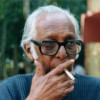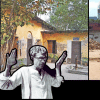Ritwik Ghatak’s revolutionary film language

In terms of gauging the evolution of filmmaking since its inception, the year 1927 added a new dimension to the language of films. Attempts to express humane sentiments became a little easier and gradually films became a powerful tool for expressing said emotions. This optimal tool was used majestically in Bengali films by the proverbial Ritwik Ghatak.
Today marks the 49th death anniversary of revolutionary filmmaker and poet Ritwik Kumar Ghatak, on account of which this is a look at how his footprints transformed films.

Tangible components exist with a guarantee of collapsing or falling apart. Grandiose things like river banks, buildings, or even meager glass breaks. Then again, when they break they tend to inflict the reverberation of their breaking using sounds. Emotions or intangible elements like heartbreaks however have no sound to them. Sure emotions are emoted with the use of language, weeps, screams, and even silence but these expressions may fall short of conveying their intensity.

The advent of films in 1895 recognised them as distinctive mediums of expressing human emotions including the then format of the making of films — silent films. The camera, the orchestral tones, and the performances of the actors became the language of the films.
Regarding movies, Ritwik once said, "I will push to let everyone know that my stories are not contrived products or that I intend to provide some cheap production. My films intend to awaken something within the minds of people. A film isn't exactly a flower, it is a weapon."

The fact that Ritwik Ghatak carried a wound regarding the partition of India in his heart was manifested through his films like, "Meghe Dhaka Tara", "Komal Gandhar", and "Subarnarekha", to name a few. He brought forward various assortments of the humane mind in them.
He portrayed the bare reality of socio-economic brutalities in films such as "Titash Ekti Nadir Naam", "Ajantrik", "Nagarik", "Runaway", "Reason, Debate and a Story" etc. All of this can be possible only when a director masterfully curates the language of films.

Again, any language becomes stronger through the words used. There are usually five types of sound used by filmmakers — speech/dialogue, music, sound effects, visual effects, and silence. Amongst these silence is the most significant element for rhyming narratives as it can control and convey stolidity as the historic filmmaker made aptuse of it..
Ritwik Ghatak used to also play well with words. On the summit of two Bengals, he wedded his films beautifully as though he elicited the longing for life through reverberating cries with his particular stylisation of sounds. This style makes his films artistic. All the attributes mentioned so far categorise Ritwik Ghatak as a revolutionary director.
This article was first published on November 4, 2023, in The Daily Star.

 For all latest news, follow The Daily Star's Google News channel.
For all latest news, follow The Daily Star's Google News channel. 








Comments